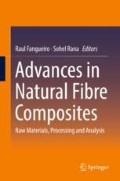Abstract
This chapter presents the impact behavior of a recently developed green composite material made of Manicaria saccifera natural fabric reinforced Poly-Lactic Acid (PLA). Composite coupons made of PLA and Manicaria saccifera fabric were produced by compression molding using the film stacking method. The composite ballistic limit (V50) was determined by subjecting PLA/Manicaria coupons, of varying lay-ups and thicknesses, to ballistic impact loading using fragment simulating projectiles (FSPs) according to the MIL-STD-662F standard. It was found that coupons with areal densities between 0.2 and 0.3 g/cm2 displayed a V50 between 50 and 70 m/s. Also, it was found that the V50 increased nonlinearly as a function of coupon thickness, but it does not depend on the composite stacking sequence. Finally, the energy absorbed by the material at impact on complete penetrations is uniform and independent of the striking velocity, whereas for partial penetrations increases exponentially.
Access this chapter
Tax calculation will be finalised at checkout
Purchases are for personal use only
References
Laborel-Préneron, A., et al. (2016). Plant aggregates and fibers in earth construction materials: A review. Construction and Building Materials, 111, 719–734.
Korjenic, A., Zach, J., & Hroudová, J. (2016). The use of insulating materials based on natural fibers in combination with plant facades in building constructions. Energy and Buildings, 116, 45–58.
Mohanty, A., Misra, M., & Drzal, L. (2002). Sustainable bio-composites from renewable resources: Opportunities and challenges in the green materials world. Journal of Polymers and the Environment, 10(1), 19–26.
O’donnell, A., Dweib, M., & Wool, R. (2004). Natural fiber composites with plant oil-based resin. Composites Science and Technology, 64(9), 1135–1145.
Burgueño, R., et al. (2004). Load-bearing natural fiber composite cellular beams and panels. Composites Part A Applied Science and Manufacturing, 35(6), 645–656.
Kalyankar, R., & Uddin, N. (2012). Structural characterization of natural fiber reinforced polymeric (NFRP) laminates for building construction. Journal of Polymers and the Environment, 20(1), 224–229.
Singh, B., et al. (2011). Natural fiber-based composite building materials. In Cellulose fibers: Bio-and nano-polymer composites (pp. 701–720). Berlin: Springer.
Faruk, O., et al. (2012). Biocomposites reinforced with natural fibers: 2000–2010. Progress in Polymer Science, 37(11), 1552–1596.
Jover, N., Shafiq, B., & Vaidya, U. (2014). Ballistic impact analysis of balsa core sandwich composites. Composites Part B Engineering, 67, 160–169.
Ahmad, M. R., et al. (2008). Effect of fabric stitching on ballistic impact resistance of natural rubber coated fabric systems. Materials and Design, 29(7), 1353–1358.
Cheeseman, B. A., & Bogetti, T. A. (2003). Ballistic impact into fabric and compliant composite laminates. Composite Structures, 61(1), 161–173.
Lee, Y. S., Wetzel, E. D., & Wagner, N. J. (2003). The ballistic impact characteristics of Kevlar® woven fabrics impregnated with a colloidal shear thickening fluid. Journal of Materials Science, 38(13), 2825–2833.
Yahaya, R., et al. (2016). Investigating ballistic impact properties of woven kenaf-aramid hybrid composites. Fibers and Polymers, 17(2), 275–281.
Nguyen, L., et al. (2016). The efficiency of ultra-high molecular weight polyethylene composite against fragment impact. Experimental Mechanics, 56(4), 595–605.
Morye, S., et al. (2000). Modelling of the energy absorption by polymer composites upon ballistic impact. Composites Science and Technology, 60(14), 2631–2642.
Nunes, L., Paciornik, S., & d’Almeida, J. (2004). Evaluation of the damaged area of glass-fiber-reinforced epoxy-matrix composite materials submitted to ballistic impacts. Composites Science and Technology, 64(7), 945–954.
Deka, L., Bartus, S., & Vaidya, U. (2008). Damage evolution and energy absorption of E-glass/polypropylene laminates subjected to ballistic impact. Journal of materials science, 43(13), 4399.
Wambua, P., et al. (2007). The response of natural fibre composites to ballistic impact by fragment simulating projectiles. Composite Structures, 77(2), 232–240.
Nascimento, L. F. C., et al. (2017). Evaluation of ballistic armor behavior with epoxy composite reinforced with Malva fibers. In Characterization of Minerals, Metals, and Materials (pp. 647–655). Berlin: Springer.
Porras, A., Maranon, A., & Ashcroft, I. (2015). Characterization of a novel natural cellulose fabric from Manicaria saccifera palm as possible reinforcement of composite materials. Composites Part B Engineering, 74, 66–73.
Gupta, A., & Kumar, V. (2007). New emerging trends in synthetic biodegradable polymers–polylactide: A critique. European Polymer Journal, 43(10), 4053–4074.
Shih, Y.-F., Huang, C.-C., & Chen, P.-W. (2010). Biodegradable green composites reinforced by the fiber recycling from disposable chopsticks. Materials Science and Engineering A, 527(6), 1516–1521.
Mohanty, A. K., Misra, M., & Drzal, L. T. (2005). Natural fibers, biopolymers, and biocomposites. Boca Raton: CRC Press.
Porras, A., Maranon, A., & Ashcroft, I. (2016). Optimal tensile properties of a Manicaria-based biocomposite by the Taguchi method. Composite Structures, 140, 692–701.
Buchely, M. F., Maranon, A., & Silberschmidt, V. V. (2016). Material model for modeling clay at high strain rates. International Journal of Impact Engineering, 90, 1–11.
MIL-DTL-46593B—Projectile, Calibers 0.22, 0.30, 0.50, and 20 MM Fragment Simulating, 2006.
Stilp, A. J. (2005). Sabot designs for launching penetrators and projectiles. In High-pressure shock compression of solids VIII (pp. 201–225). Berlin: Springer.
MIL-STD-662F, Military standard V50 ballistic test for armor, 1997.
Abrate, S. (2007). Ballistic impact on composites. In 16th International Conference on Composite Materials.
Hsieh, A. J., et al. (2004). The effects of PMMA on ballistic impact performance of hybrid hard/ductile all-plastic-and glass-plastic-based composites, DTIC Document.
Nilakantan, G., & Nutt, S. (2014). Effects of fabric target shape and size on the V50 ballistic impact response of soft body armor. Composite Structures, 116, 661–669.
Porras, A., Maranon, A., & Ashcroft, I. (2016). Thermo-mechanical characterization of Manicaria saccifera natural fabric reinforced poly-lactic acid composite lamina. Composites Part A Applied Science and Manufacturing, 81, 105–110.
Author information
Authors and Affiliations
Corresponding author
Editor information
Editors and Affiliations
Rights and permissions
Copyright information
© 2018 Springer International Publishing AG
About this paper
Cite this paper
Quintero, S., Porras, A., Hernandez, C., Maranon, A. (2018). The Response of Manicaria saccifera Natural Fabric Reinforced PLA Composites to Impact by Fragment Simulating Projectiles. In: Fangueiro, R., Rana, S. (eds) Advances in Natural Fibre Composites. Springer, Cham. https://doi.org/10.1007/978-3-319-64641-1_9
Download citation
DOI: https://doi.org/10.1007/978-3-319-64641-1_9
Published:
Publisher Name: Springer, Cham
Print ISBN: 978-3-319-64640-4
Online ISBN: 978-3-319-64641-1
eBook Packages: Chemistry and Materials ScienceChemistry and Material Science (R0)

